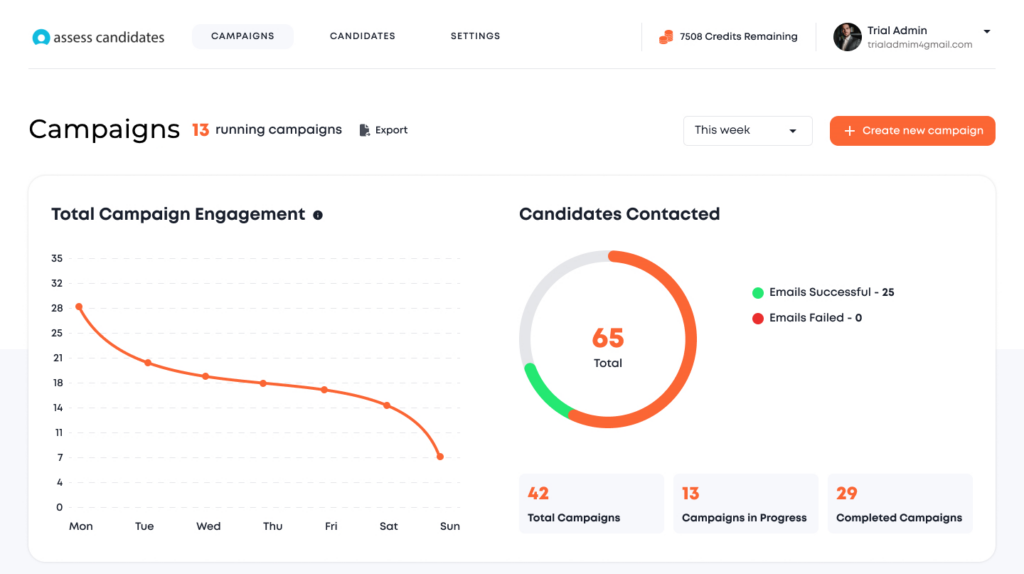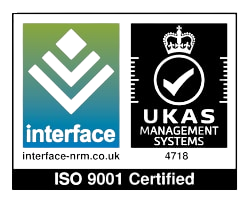How often should companies update their candidate pre-employment assessments?
The landscape of talent acquisition is always changing, and so is the business environment your company operates in. To stay ahead you need to reflect on your future recruitment campaigns, especially how you plan to update candidate assessments to keep your process relevant.
In this article we look at the reasons for which candidate assessments should be continuously updated and refined. We also analyze different factors which impact how often companies should update their recruitment campaigns. Finally, we share best practice strategies for recruiters and HR professionals planning any changes or regular updates to their recruitment processes.
Let’s get started.
Contents:
- Why do companies need to update their recruitment processes?
- What are the factors determining the frequency at which employers need to update to their assessments?
- What are the best practice strategies for updating candidate pre-employment assessments?
- Why are Assess Candidates assessments a good choice for your company’s assessment process?
- FAQs and Glossary of Terms.
1. Why do companies need to update their recruitment processes?
As businesses strive to remain agile, resilient, and responsive to the demands of a changing world, updating pre-employment assessments plays a key role in ensuring that organizations stay competitive and attract the right talent. Below we look at eight main reasons and benefits of why companies decide to update their recruitment processes.
8 reasons companies make changes to their recruitment campaigns:
- Adaptation to Technological Advancements: The tools and technologies available for assessing candidates are constantly evolving. Companies need to harness the power of cutting-edge assessment tools to ensure they are not left behind. Incorporating artificial intelligence, machine learning, and other advanced technologies can enhance the accuracy and efficiency of the recruitment process.
- Alignment with Industry Trends: Industries undergo transformations, and the skills required for success change accordingly. Updating assessments allows companies to align their evaluation criteria with current industry trends, ensuring that they are evaluating candidates based on the skills and competencies that are most relevant to the current business landscape.
- Enhanced Diversity and Inclusion: Traditional assessment methods may inadvertently introduce biases that hinder diversity and inclusion efforts. Regular updates to assessment processes provide an opportunity to identify and eliminate biases, ensuring a fair and inclusive evaluation of candidates. This is crucial for fostering a diverse workforce that brings a variety of perspectives and ideas to the table.
Company diversity matters to 76% of job seekers.
Glassdoor
- Candidate Experience Improvement: Outdated assessment processes can lead to a poor candidate experience. As the job market becomes more competitive, providing a positive candidate experience is essential for attracting top talent. Updating assessments can streamline the application and evaluation process, making it more user-friendly and efficient for candidates.
- Better Prediction of Job Performance: The ultimate goal of any recruitment process is to identify candidates who will excel in their roles. Regularly updating assessments allows companies to refine their criteria and methodologies, leading to more accurate predictions of a candidate’s potential job performance. This ensures that organizations make informed hiring decisions that contribute to long-term success.
Psychometric tests can save employers as much as two years of on-job training by identifying the right talent for job responsibilities.
Alison Wolf and Andrew Jenkins (2002)
- Adaptation to Evolving Business Operations: Companies must ensure that their recruitment processes align with new strategies and objectives. Updating assessments is crucial for adapting to shifts in organizational priorities and ensuring that the hiring process reflects the current operational needs of the business.
- Regulatory and Compliance Requirements: The regulatory environment governing hiring practices is subject to change. Companies need to stay abreast of these alterations to maintain compliance and adhere to legal standards. Regularly updating assessments ensures that they remain in line with the latest regulations, safeguarding the organization against legal challenges and fostering a commitment to ethical and compliant hiring practices.
- Industry Leadership and Competitive Edge: Staying competitive is paramount in today’s fast-paced business world. Regularly updating assessments positions a company as a leader in its industry, showcasing a commitment to innovation and a forward-thinking approach to talent acquisition. This competitive edge can be a decisive factor in attracting top talent who are drawn to organizations that embrace the latest advancements in recruitment processes.

Future-proof hiring for tomorrow’s top talent. View Plans
2. What are the factors determining the frequency at which employers need to update to their assessments?
After seeing the reasons for keeping the candidate assessments updated, let us now look at the next important question – How often is enough? There is no straight answer to this question because each company is unique and requires a tailored approach to hiring.
In general, the frequency at which employers need to update their assessments depends on various factors that recruiters need to take into account. Let’s see a few examples.
Which factors determine the frequency of candidate assessment updates?
- Industry Dynamics: Industries experiencing rapid changes, such as technology or healthcare, may require more frequent assessment updates to stay ahead of evolving skill requirements.
- Regulatory Changes: Legal and regulatory frameworks governing recruitment practices may change. Companies must update assessments to ensure compliance with new laws and regulations related to hiring and diversity.
- Feedback and Analytics: Regularly reviewing feedback from recruiters, hiring managers, and candidates, coupled with data analytics, can highlight areas for improvement in the assessment process, indicating the need for updates.
A recent study found that companies using pre-employment assessments experienced a 39% lower hiring error rate compared to those that didn’t use such tools.
Aberdeen Group
- Competitive Benchmarking: The practice of benchmarking against industry peers is prevalent in talent acquisition. Regularly assessing and comparing the effectiveness of assessments against competitors can be a catalyst for updates, ensuring that an organization’s recruitment processes remain on par with or surpass industry standards.
- Emerging Skill Requirements: The evolution of required skills is not confined to specific industries. Rapid changes in skill demands across various sectors may prompt companies to update assessments to align with emerging competencies, ensuring that they accurately reflect the skills essential for success in contemporary roles.
- Technological Advancements: The pace of technological advancements directly impacts the need for assessment updates. If new technologies emerge that can enhance the assessment process, companies should incorporate them promptly.
- Organizational Growth: As companies expand, the types of roles they need to fill may change. Assessment processes must evolve to accommodate these shifts in job requirements and organizational goals.
A recent survey conducted states that 81% of companies across 14 countries believe that psychometric tests ensure well assured and more reliable hiring decisions.
Global Assessment Barometer

3. What are the best practice strategies for updating candidate pre-employment assessments?
Updating candidate pre-employment assessments is a strategic process that requires careful planning and execution. By adhering to these best practices, companies can ensure that their recruitment processes remain effective, efficient, and aligned with the evolving needs of the business landscape.
Read below for a step-by-step guide outlining best practices for updating pre-employment candidate assessments.
8 steps to updating your candidate assessment process
- Conduct a Comprehensive Assessment Audit: Review existing assessments to identify strengths and weaknesses. Gather feedback from stakeholders, including recruiters, hiring managers, and candidates. Analyze data on assessment results and performance metrics.
Companies recording positive candidate feedback on hiring experience also reported a 70% improvement in the quality of hires.
Glassdoor
- Stay Informed About Industry Trends: Monitor industry trends to understand the evolving skill sets and competencies required. Collaborate with industry experts, attend conferences, and engage in continuous learning to stay abreast of changes affecting your sector.
- Utilize Technology Wisely: Leverage advanced technologies such as artificial intelligence and machine learning to enhance the accuracy and efficiency of assessments. Regularly assess and adopt new technologies that can improve the overall assessment process.
- Prioritize Diversity and Inclusion: Implement strategies to eliminate biases in assessment processes. Provide training to recruiters and assessors on diversity and inclusion best practices. Regularly review and update assessments to ensure fairness and inclusivity.
- Involve Key Stakeholders: Collaborate with recruiters, hiring managers, and other key stakeholders in the assessment update process. Gather diverse perspectives to ensure a well-rounded evaluation of the assessment criteria.
Did you know that managers who use pre-employment assessments for recruitment report 36% more satisfaction with their hiring decision than those managers who don’t?
Aberdeen Group
- Pilot New Assessments: Before fully implementing updated assessments, conduct pilot programs to test their effectiveness. Collect feedback from pilot participants to identify any unforeseen issues or areas for improvement.
- Communicate Changes Effectively: Clearly communicate changes to candidates, recruiters, and hiring managers. Provide training and resources to ensure everyone involved in the hiring process understands the updated assessment criteria and processes.
- Measure and Iterate: Implement key performance indicators (KPIs) to measure the success of the updated assessments. Continuously collect and analyze data to identify areas for improvement and iterate on the assessment processes as needed.
Choose Assess Candidates for recruitment with timeless reliability. Hire For Free
4. Why are Assess Candidates assessments a good choice for your company’s assessment process?
Selecting the right assessment platform is critical for ensuring the success of your recruitment endeavors. Assess Candidates stands out as a top choice for your company’s recruitment needs, offering pre-employment candidate assessments rooted in research, science, and a commitment to innovation.
By choosing Assess Candidates, you not only invest in a reliable assessment platform but also align your recruitment strategy with the latest advancements in the field, ensuring a competitive edge in attracting and retaining top talent.
3 reasons to hire with pre-employment assessments from Assess Candidates
- Assessments Backed by Research: At the core of Assess Candidates’ appeal is its commitment to assessments grounded in rigorous research and scientific principles. The assessments provided by Assess Candidates are not only vetted for accuracy but are also continuously refined based on the latest findings in the field of industrial-organizational psychology. This ensures that the evaluation criteria are not only relevant but also aligned with the evolving landscape of the workforce.
- Technological Updates: We use feedback from our partners and ongoing research to continually refine and update our system. This way, our system works with you in mind and not the other way around.
- Full Guidance for Tailored Changes to Hiring: Recognizing that every company has unique needs and priorities, Assess Candidates goes beyond providing just assessments – we offer full support and guidance for tailoring assessments to specific hiring requirements. Our consultants are readily available to assist your team in customizing assessments to align with the distinct characteristics of your industry, company culture, and job roles.

Example of client problem and Assess Candidates solution
Client Problem:
A growing fintech company previously used a one-size-fits-all approach to candidate screening in which technical aptitude tests were used standalone. With growing distinctions in role, the business leaders were looking for an automated system which will make administration of various recruitment campaigns easier.
Assess Candidate Solution:
Leverage an easy-to-use platform that resonates with the company’s brand. Use state-of-the-art assessments that tap into the key areas of performance, rather than technical ability alone.
5. FAQs and Glossary of Terms
FAQs
- Why is it essential for companies to update their recruitment processes regularly?
- In the dynamic modern workplace, technological advancements and societal shifts continually reshape industries. Regular updates to recruitment processes are crucial to stay competitive, attract top talent, and align with evolving industry standards.
- How does adapting to technological advancements benefit recruitment processes?
- Embracing cutting-edge assessment tools, such as artificial intelligence and machine learning, enhances the accuracy and efficiency of recruitment. Staying abreast of technological trends ensures companies don’t lag behind in leveraging the latest tools.
- How do updated assessments contribute to diversity and inclusion efforts?
- Traditional assessment methods may introduce biases. Regular updates provide an opportunity to identify and eliminate biases, fostering a fair and inclusive evaluation of candidates. This is essential for building a diverse workforce with varied perspectives.
- Why is candidate experience improvement a significant consideration for updating assessments?
- In a competitive job market, a positive candidate experience is crucial for attracting top talent. Updating assessments streamlines the application and evaluation process, making it user-friendly and efficient for candidates.
- How does updating assessments contribute to better prediction of job performance?
- The ultimate goal of recruitment is to identify candidates who will excel in their roles. Regular updates allow companies to refine criteria and methodologies, leading to more accurate predictions of a candidate’s potential job performance.
- What factors determine the frequency of assessment updates for employers?
- The frequency depends on industry dynamics, regulatory changes, feedback and analytics, technological advancements, and organizational growth. Rapidly changing industries and regulatory landscapes may necessitate more frequent updates.
Glossary of Terms
- Industry Dynamics: The forces and factors that shape and change industries, influencing skill requirements and job roles.
- Bias Elimination Strategies: Techniques and approaches aimed at identifying and removing biases from assessment processes to ensure fair and inclusive evaluations.
- Candidate Experience: The overall journey and interactions a candidate has during the recruitment process, from application to onboarding.
- Key Performance Indicators (KPIs): Quantifiable metrics used to measure the success and effectiveness of recruitment processes and updated assessments.
- Pilot Programs: Small-scale testing initiatives conducted before the full implementation of updated assessments to identify issues and gather feedback.
- Regulatory Changes: Modifications in laws and regulations governing recruitment practices, requiring companies to update assessments to ensure compliance.
- Technological Advancements: Innovations and improvements in technology, such as artificial intelligence and machine learning, that can enhance the accuracy and efficiency of assessment processes.
